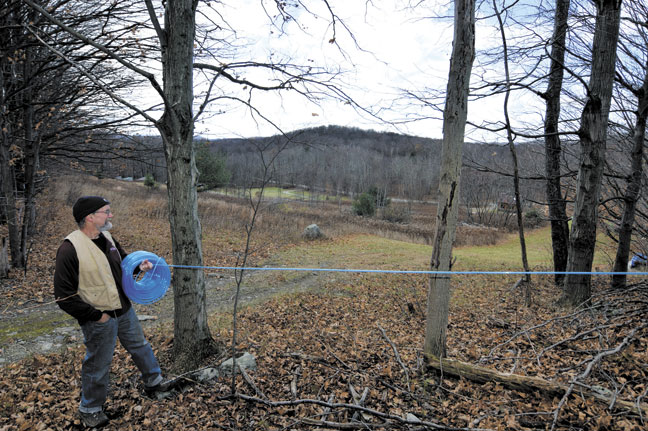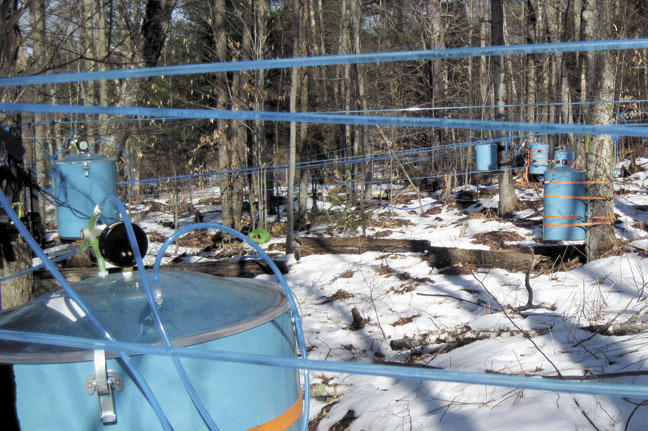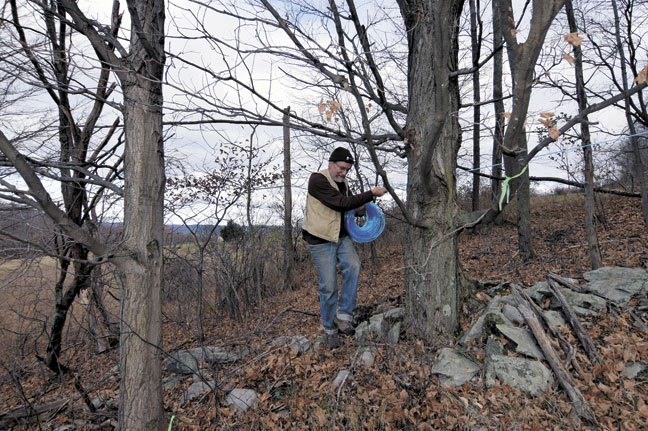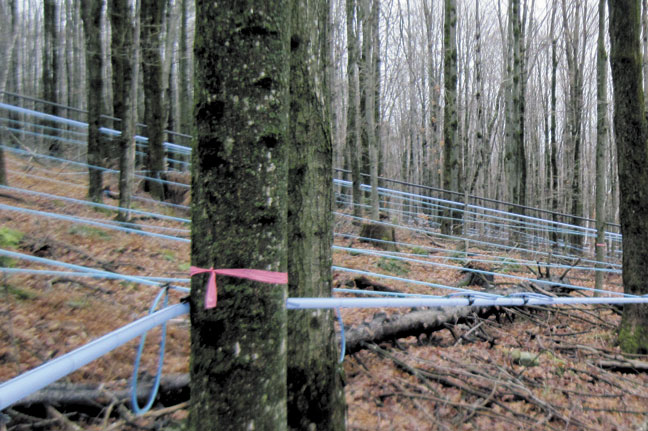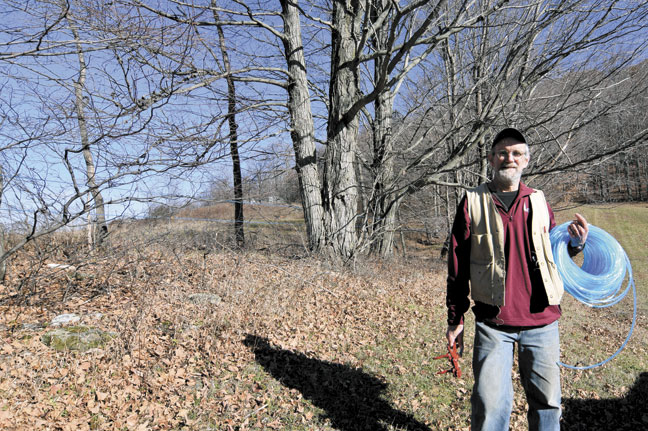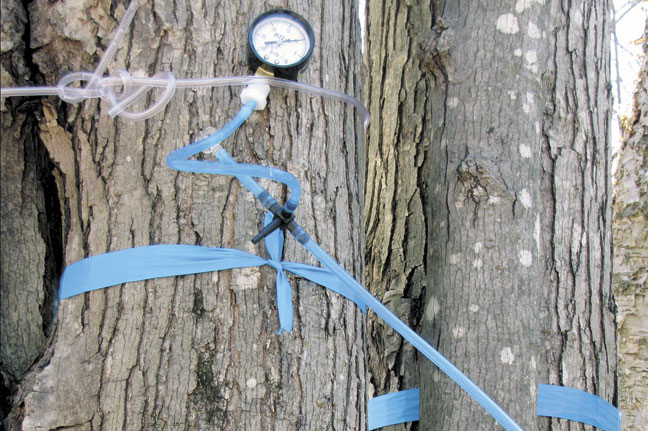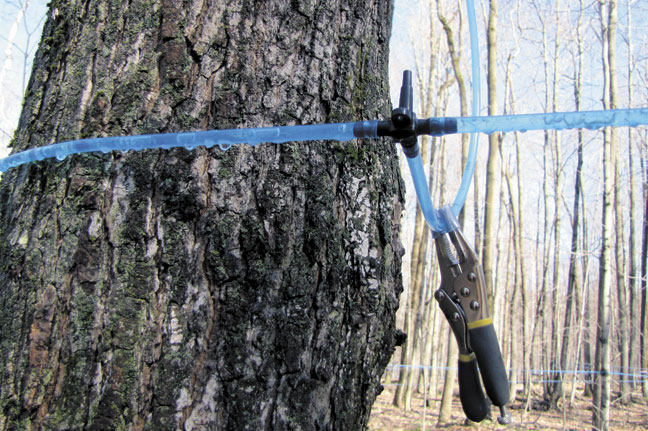Tapping & Tubing
3/16ths guru Tim Wilmot: Using 3/16th tubing with a pump
On a slope, a pump could help increase production
By TIMOTHY WILMOT RESEARCHER, DOMINION & GRIMM INC. RETIRED, UNIVERSITY OF VERMONT EXTENSION MAPLE SPECIALIST | JAN. 25, 2018
In addition to the advantages that 3/16” tubing provides in creating natural (gravity) vacuum on a slope, there is also an advantage that small diameter tubing can provide in some pumped systems. As is true with an all gravity system, the goal is to maximize vacuum at each taphole. Research has shown that an increase in vacuum at the taphole is accompanied by a steady increase in sap production—the relationship is about 5% more sap for every additional inch of mercury. In many pumped systems, because of friction loss and the capabilities of the pump itself, the vacuum at the taphole is less, sometimes much less, than the maximum that is possible at that elevation. On a slope, the vacuum that can develop in 3/16” lines can increase what is achieved in the mainline by the pump, and this increase may boost production. The vacuum in the small lines is developed by the weight of the sap, while the vacuum in the mainline comes from the steady removal of air by the pump; together they form what I call a hybrid. This type of system is somewhat newer than the all gravity 3/16” system, and its design, for example the optimum number of taps per line, is less straight forward. This article summarizes the research that I have conducted on 3/16” hybrid systems; unless otherwise noted, all of the results reported here are my own.
The hybrid system: boosting the mainline vacuum
The experiments described below were designed to examine the possible advantages of hybrid systems that employed pumps of various capabilities and mainline systems of different complexities. The simplest system was one where a small stand of trees was located on a uniform (at a constant angle) shallow slope, which made an all gravity arrangement less than satisfactory. Here the longest lines could only be about 200’, while some lines were less than 100’. Because of the limited line length, gravity vacuum at the top-most tapholes varied from about 23” to only 10-12” in the shortest lines. Taps near the bottom of the slope had very little vacuum. The lateral lines were then connected to a mainline, which was served by a diaphragm pump. When the pump was turned on, it generated a vacuum of 18” in the mainline (although diaphragm pumps are often capable of much better vacuum than this) and the vacuum levels at the lowest tapholes, closest to the mainline, were now at a minimum of 18”. The vacuum at the top of all the lines, even the shorter lines that had previously measured 10”, now measured 26-28”; in the case of the shortest lines this was almost the sum of the gravity vacuum plus the mainline vacuum. Thus a simple pump added to 3/16” gravity lines on less than ideal terrain resulted in a system that was capable of good sap production, where neither the pump nor the gravity lines alone would have been satisfactory.
Another set of experiments examined 3 sugarbushes with high vacuum pumps in order to compare vacuum in the mainline with the vacuum at the end of 3/16” lateral lines. Measurements were made in areas that had low to moderate uniform slopes of 5% to about 20%. Lateral lines varied from about 50-200’ in length. The number of taps per line ranged from 2 to 12 although most lines had from 4 to 8 taps. Mainline vacuum near the lateral lines that were being examined varied from about 22” (where the pump was too small for the large operation) to 27+”. The following conclusions can be made about these hybrid systems:
In all cases, unless there was a leak on the lateral line, the vacuum at the top of the 3/16” line was stronger than the vacuum in the mainline.
The gain in vacuum at the top of the lines was related to the difference in height between the mainline and the top of the line. This closely follows results that were seen in many gravity experiments, as described in the previous article on gravity tubing.
Where the mainline vacuum was very strong, the maximum vacuum was achieved at tapholes that were only a few feet higher than the mainline.
With moderate to strong sap flow the number of taps did not seem to influence the amount of vacuum gained in the 3/16” line. Lines with as few as 2 taps gained considerable vacuum. On a few days when sap flow was weak, the gain in vacuum on short lines with few taps was diminished somewhat, apparently because there was not enough sap in these lines to produce the weight necessary for good natural vacuum.
In virtually all cases when the height difference between the mainline and the top of the lateral line was enough—a few feet when the mainline vacuum was 27”, 12-20 feet when the mainline vacuum was 22”—the top was at the maximum possible vacuum for that elevation. The maximum varies with altitude and is about 28.3” at 1500’ above sea level.
These conclusions indicate that substituting 3/16” tubing for 5/16” should result in some vacuum gains when using lines that are fairly similar in arrangement to those used in a modern 5/16” system. Several words of caution however are appropriate. All of these systems were on a slope, and the height of the tapholes above the mainline was important. All of the vacuum readings reported here were from the top of the line; trees that are lower on the line will have less benefit from gravity and thus may not achieve the maximum possible vacuum. On days with weak sap flow, shorter lines with few taps may not contain enough sap for the addition of much vacuum. Finally, it should be noted that these experiments measured vacuum only and not sap production. Factors that may influence total sap production, including the possible clogging of the lines as they get older or are not cleaned, should also be taken into account, as described below.
The shape of the 3/16” lines in a pumped system
The question arises whether some design practices that have proved successful in pumped systems with 5/16” tubing should be followed with 3/16” tubing. Sugarmakers with pumped systems using 5/16” tubing have emphasized the importance of keeping the lateral lines as straight as possible to reduce friction loss in the tubing. Conversely, crooked lines do not seem to affect vacuum or sap yield in all-gravity systems. An experiment to compare straight versus very crooked lines in a pumped system using 3/16” tubing was conducted on a site with a mild (10-15%) slope. Multiple straight lines, each about 200’ long and with about 7 taps each were interspersed with lines that zig-zagged down the slope. The crooked lines were 50% longer because of weaving back and forth, and had an average of 12 taps. Sap was collected using diaphragm pumps that produced 22-24” of vacuum at the pump. At the top of the lines, the vacuum in both types of tubing was virtually identical at 27.5” with the pumps turned on. Sap yield for the season was slightly better from the straight lines (3% larger yield); however, this difference was not statistically significant, indicating that the difference could likely be attributed to chance and not the shape of the lines. Given this minor difference in yield, and the fact that the crooked lines had very exaggerated back and forth bends, it is concluded that the shape of the 3/16” lines in a pumped system is not an important factor.
Line length and number of taps per line
Experiments with gravity-only 3/16” tubing showed that nearly identical sap yields could be obtained on similar slopes using lines of very different lengths and greatly varying numbers of taps per line, as described in the previous article on gravity tubing. Could the same be true in a pumped system? To help answer this question, an experiment was designed in 2017 to compare vacuum and yield in lines with 5 taps each vs. lines with 15 taps each, on a site with a 10-15% slope. Four of each type of line were tested. At this site, due to a number of factors, mainline vacuum was quite low (18-22”) and thus the potential for the 3/16” lines to boost the vacuum by gravity was quite large. The height needed to boost the vacuum from the mainline to the top of the lateral, and achieve the maximum possible vacuum at this site required that the top of the line be at least 15’ higher than the mainline. Maples at the site were dispersed enough that the 5 tap lines averaged 200’ long, (and tops of the lines were 20-30’ above the mainline) while the 15 tap lines averaged 400’ long. The actual vacuum at the tops of all the lines was around 28.5” and there was no difference between the 5 and 15 tap lines.
Sap volume, which was collected in large vacuum chambers, was measured daily. At the end of the season, the volume collected from the 5 tap lines was 13% greater than from the 15 tap lines, an amount which was statistically significant. This rather surprising result deserves a search for explanations (and speculation).
The average tree dbh on the 5 tap lines was 1.75” larger than the average dbh on the 15 tap lines. According to a recent article, Understanding the relationship between tree size and yield, published in the Maple News (11/17 issue) by Perkins, Isselhardt and van den Berg of the UVM Proctor Center, this could account for the difference in yield between the two types of lines. On the other hand, a larger percentage of trees on the 5 tap lines were lower on the slope, thus close enough to the mainline that they would not have received the maximum 28.5” of vacuum. In a test to reduce the number of taps on the 15 tap lines, every other dropline was clamped off. This mostly resulted in sap yields that mirrored the yields from the 5 tap lines, indicating that there was something about the greater number of taps that reduced yield. Finally, an experiment that involved placing vacuum gauges by every dropline on 15 tap lines, and successively clamping off the whole line above each taphole, showed that all along the line, the vacuum increased when there was no sap flowing from above that taphole. This suggests that sap from droplines in the middle of the line may be somewhat restricted by the rapid flow of sap down the line.
All of this may not be of great importance, and it should be emphasized that this particular comparison of lines was one of many possible, using varying tap numbers, line lengths, mainline vacuum, and terrain contours. With line length and tap number, certain tradeoffs are inevitable. Lines with more taps allow less mainline to be used, which reduces certain costs and maintenance. Lines that are too long may be hard to monitor for leaks. In the case of this sugarbush, several power outages and problems in the sap shed caused all mainline vacuum to be lost for a number of hours. When this happened, the longer lines benefitted more, as they had a large number of taps that were well uphill from the mainlines, and thus much gravity vacuum was generated. What was most important to note was that in this sugarbush, the low mainline vacuum, caused in part due some poor tapping and taphole leaks in other areas of the bush, did not result in poor sap yields—the average yield in the research area of the woods was over 30 gallons of sap per tap, because of the additional vacuum generated by gravity in the 3/16” lines.
Tapping on flat land and the possible benefit of the 3/16” dropline
While 3/16” tubing was meant to be used on a slope, some people have recommended its use on flat land, theorizing that the vacuum developed in the dropline alone will provide adequate vacuum. A 36” dropline that leads straight down to the lateral should, if full of sap, provide a little less than 3” of vacuum at the top. Tests were made see if the vacuum differed along droplines from top to bottom, or if the vacuum at the top of a dropline exceeded the vacuum on the nearby lateral line. Gauges almost always read the same. Additionally, it was noted in examination of many droplines during various times and conditions of sap flow that the droplines were almost never full. The exceptions were when the lateral line had leaks and the flow down the line was so rapid that sap could not exit the droplines; or when part of the line was frozen and sap was backed up. Occasionally during normal flow the sap would rise several inches above the T in each dropline, but this would provide at best very little additional vacuum, and it is questionable whether this would occur on flat ground.
Cleaning 3/16” tubing in a pumped system
As described in a previous article on gravity collection, it is highly recommended that 3/16” tubing be cleaned at the end of the season. While the usual method of pulling spouts under vacuum has worked for many 5/16” pumped systems, this is not likely to be adequate in a 3/16” system, as the sap clings to the tubing much more readily. Reports of declining production in 3/16” systems after year one are not uncommon in tubing that is not cleaned. Perhaps the fastest method, commonly used in Canada, is to squirt a small amount of a cleaning solution into each spout while the pump is on, using a backpack and “gun”. Cleaning solutions should be rinsed or the first sap should be drained onto the ground when this method is used. The alternatives might be an air/water cleaning, or the use of check valve spouts after year one.
Finding leaks in the tubing
Perhaps the most compelling reason for many producers with pumped systems to convert some tubing to 3/16” is the increased ease in identifying leaks. Even more than in gravity-only tubing, leak-affected flow in 3/16” lines that are part of a hybrid system is often readily visible from some distance. The presence of the pump seems to add air to leaking lines, and this can make the rapid flow in these lines show up in stark contrast to unaffected lines. At the mainline manifold, a leaking line will may sometimes appear to have no discrete bubbles or packets of sap, instead the flow is often visible as a thin stream pasted against the side of the tube. Following uphill to find a leak, the culprit is usually seen by rapid spurting from the spout (best seen in clear spouts) if the hole is bad, or in the introduction of many air bubbles and increased sap speed where an affected dropline joins the lateral at the T. The most useful tool for confirming these leaks is pair of vise grips to block off the suspect dropline—applying this should immediately reduce the speed of the sap below the T. Tubing that is relatively soft and transparent is the best type for observing and closing off these leaks.
Conclusion
For some producers using less expensive or reliable pumps, and/or for whom the concept of longer tubing lines and less mainline, and easier leak detection is attractive, a hybrid system that boosts mainline vacuum with the addition of gravity vacuum may be a viable option. As mentioned at the beginning of this article, the recommended practices for a 3/16” tubing system with a pump are not entirely straightforward—for example the ideal number of taps on a line is still uncertain. Tubing maintenance, especially cleaning, will deter some potential users. Many producers with high vacuum pumps may feel that there is no need to supplement the taphole vacuum in the bush; however, gauges placed in different areas may indicate areas where friction or other factors does not allow the high pump-house vacuum to reach distant areas. With a potential gain of 5% sap yield for every increased inch of vacuum at the taphole, there is significant production that can be achieved in these areas.
As in all previous discussions of 3/16” tubing, I welcome your comments, observations, and questions, and hope to share more information about these systems in the future. I can be reached at timothy.wilmot@uvm.edu.















